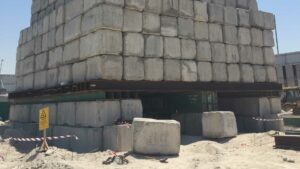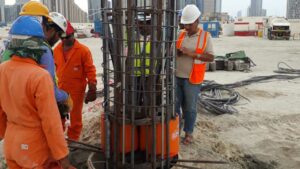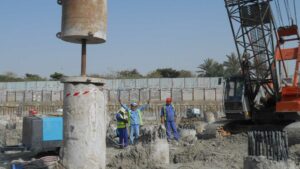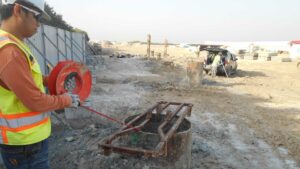Testing to Assure Quality
Our exacting quality control system is implemented by qualified engineers, who observe, monitor, verify and inspect all definable features of work on a project in order to assure conformance to strict standards
Our testing procedures include:
Static load testing
 This is the most reliable method of determining pile load capacity. It is the most fundamental form of pile load test and is considered as the benchmark of pile performance. It involves the direct measurement of pile head displacement in response to a physically applied test load. This method is applicable to all types of piles regardless of their method of installation.
This is the most reliable method of determining pile load capacity. It is the most fundamental form of pile load test and is considered as the benchmark of pile performance. It involves the direct measurement of pile head displacement in response to a physically applied test load. This method is applicable to all types of piles regardless of their method of installation.
Osterberg Cell (O-Cell) testing
 The O-cell is a hydraulically driven, high capacity, sacrificial jacking device installed within the foundation unit. Working in two directions, upward against side-shear and downward against end-bearing, the O-cell automatically separates the resistance data.
The O-cell is a hydraulically driven, high capacity, sacrificial jacking device installed within the foundation unit. Working in two directions, upward against side-shear and downward against end-bearing, the O-cell automatically separates the resistance data.
By virtue of its installation within the foundation unit, the O-Cell load test is not restricted by the limits of overhead structural beams and tie-down pile Instead, the O-cell derives all reaction from the soil and/or rock system. It is a convenient, economical and safe method as no reaction system is required.
Pile Integrity Testing
 Pile Integrity Test, also known as Pulse Echo Test, Sonic Echo Test and Low Strain Impact Integrity Test, is a rapid, inexpensive, non-destructive method to check for pile defects such as voids, cracks, necking, inclusions, etc. It determines the pile integrity, dimensions, continuity and pile material consistency.
Pile Integrity Test, also known as Pulse Echo Test, Sonic Echo Test and Low Strain Impact Integrity Test, is a rapid, inexpensive, non-destructive method to check for pile defects such as voids, cracks, necking, inclusions, etc. It determines the pile integrity, dimensions, continuity and pile material consistency.
Caliper Logging
Caliper logging of boreholes is commonly conducted to measure variations in borehole diameter over the length of the excavation. Information of borehole diameter, shape and roughness can be used to calculate borehole volume.
Cross-hole sonic logging
 Cross-Hole Sonic Logging allows for the detection of concrete defect This method is applicable to piles of any dimensions and
Cross-Hole Sonic Logging allows for the detection of concrete defect This method is applicable to piles of any dimensions and
can be used on diaphragm wall or any similar concrete structure It gives indications of the concrete quality down the entire pile
shaft.
High strain dynamic testing
 The test is conducted by impacting the pile top with a drop hammer from a predetermined height. The basic purpose of this test is to evaluate pile static capacity, its structural integrity as well as hammer performance, pile stresses and soil characteristics, such as soil damping coefficient On-site evaluation of the test results by a trained and experienced professional would determine if the pile is to be accepted or rejected.
The test is conducted by impacting the pile top with a drop hammer from a predetermined height. The basic purpose of this test is to evaluate pile static capacity, its structural integrity as well as hammer performance, pile stresses and soil characteristics, such as soil damping coefficient On-site evaluation of the test results by a trained and experienced professional would determine if the pile is to be accepted or rejected.
DUTCH FOUNDATIONS
FOLLOW US —
